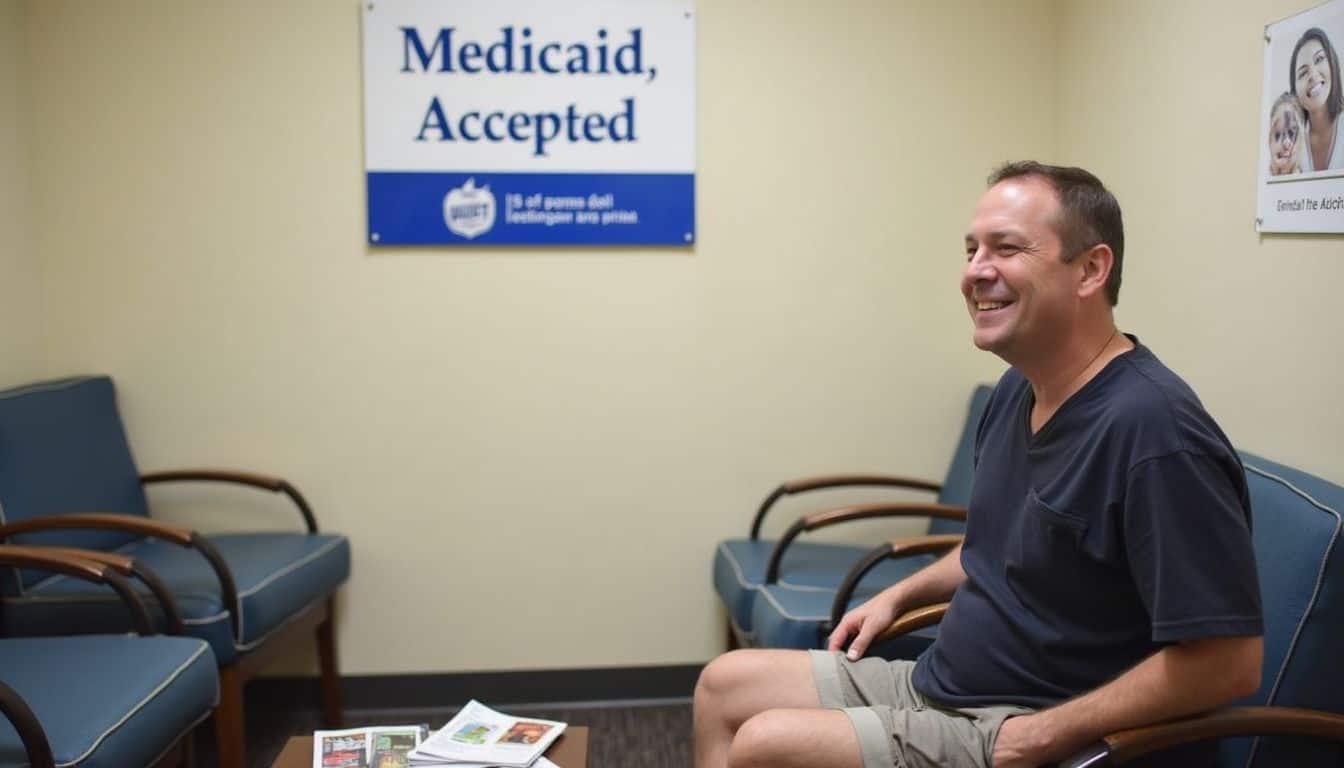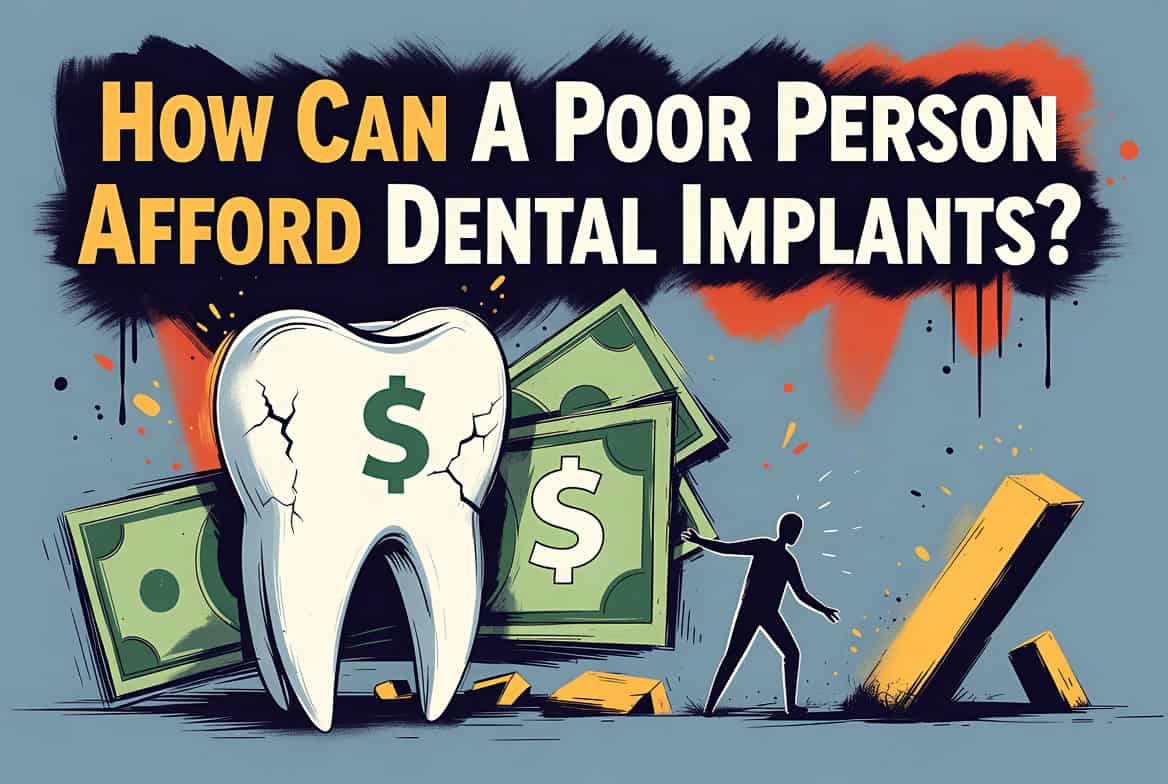Have you ever looked in the mirror and wished for a permanent solution for a missing tooth, only to feel a pit in your stomach when you think about the cost? I’ve been there, and I know how overwhelming it can be to stare at the price tag for dental implants.
It can feel like you’re stuck between wanting to restore your smile and dealing with the reality of your bank account. You might even find yourself searching online for “how can a poor person afford dental implants?”
But I want to share something that changed the game for me. I discovered that there are legitimate, smart ways to make this happen without draining your savings. For example, some dental schools can offer implants at a much lower cost than private clinics.
So, let’s walk through some real answers together. I’m going to show you the exact strategies I found, and you might be surprised at how many paths are available to you.
Key Takeaways
Dental schools and nonprofit clinics can cut implant costs by up to half; places like NYU College of Dentistry and Ben Massell Dental Clinic help low-income patients, but waitlists may be long.
Payment plans in dental offices, plus medical credit cards like CareCredit or Alphaeon, let you spread out bills over 3 to 24 months—some offer little or no interest with easy approval.
Medicaid covers adult dental care in some states like California if implants are “medically necessary,” while others do not cover adults at all; children under 19 almost always get coverage nationwide.
Crowdfunding sites such as GoFundMe and programs from groups like Donated Dental Services (DDS) raise money for implants, sometimes giving grants up to $20,000 if you meet need rules.
Getting implants abroad in Mexico can cost between $1,000-$1,500 each compared to $3,000-$5,500 in the U.S.; check dentist reviews before traveling for safety reasons.
Table of Contents
Affordable Ways to Pay for Dental Implants

Thinking about how to afford dental implants can feel like a huge challenge. But once I started exploring my options, from dental insurance to payment plans, the path forward became much clearer.
Can dental insurance help cover dental implant costs?

I’ve found that some dental insurance policies do help with dental implants, but the details really matter. Most plans come with an annual maximum benefit, which is usually between $1,000 and $2,000. That often isn’t enough to cover the entire process, especially when you add in costs for X-rays or other necessary dental work.
Many insurance companies have tricky rules that can catch you by surprise. Watch out for things like:
- Missing tooth clauses: This is a big one. Some policies won’t cover the replacement of a tooth that was lost *before* you had the insurance.
- Waiting periods: You might have to be enrolled in the plan for a specific amount of time before major procedures like implants are covered.
- Deductibles and co-payments: These are the out-of-pocket costs you have to pay before your insurance kicks in, or your share of the cost for each visit.
Because every plan is different, it’s so important to check the fine print. Before committing to a dentist for this big step, I always call my insurance company and ask for a pre-treatment estimate. This document breaks down exactly what they will pay for the advanced tooth replacement with dental implants so there are no surprises.
How do Flexible Spending Accounts (FSA) and Health Savings Accounts (HSA) work for dental implants?

While dental insurance might only cover a small portion, Flexible Spending Accounts (FSAs) and Health Savings Accounts (HSAs) have been a huge help for me in saving for dental implants. These accounts let you set aside money for medical expenses *before* taxes are taken out, which lowers your taxable income and saves you money.
For 2025, the IRS has announced new contribution limits. You can contribute up to $3,300 to a health FSA. For an HSA, the 2025 limit is $4,300 for an individual and $8,550 for a family.
The main difference to remember is the “use-it-or-lose-it” rule with FSAs. You generally have to spend the money by the end of the year, although some plans allow a small carryover amount, which for 2025 is up to $660. On the other hand, the money in my HSA rolls over every year and can even be invested, which makes it a great long-term savings tool.
Dental implants are considered a qualified medical expense for both accounts. Using these funds is simple, I just keep all my receipts from the oral surgeon and prosthodontist to document my claims. It gives me peace of mind knowing I have a dedicated fund for my oral health that also provides a nice tax benefit.
What are in-house payment plans and how can they help?

In-house payment plans offered directly by a dental office have been a lifesaver. These plans let you pay for dental implants over time, often with low or 0% interest for a set period, like 6, 12, or even 24 months.
What I love most about this option is that it often doesn’t require a hard credit check. This is a huge relief if you have a poor credit history or have faced financial struggles. Companies that partner with dentists, like Sunbit, can offer these plans and make the approval process quick and easy right in the office.
This approach breaks down a large, intimidating bill into smaller, more manageable monthly payments. Some dental offices work with financing companies like Cherry, which pay the dentist upfront while giving you the flexibility to pay off the balance over time. Each office has its own terms, so it’s always a good idea to ask about the specifics. This option can also be used for other treatments, like [interceptive orthodontic treatment](https://www.tidbitsofexperience.com/interceptive-orthodontic-vs-comprehensive/).
Financing Options for Dental Implants

Talking about money can be stressful, but there are real, practical ways to finance your new smile. From special medical credit cards to personal loans, you can find a solution that doesn’t have to break your budget.
What are medical credit cards and how can I use them?

Medical credit cards, like CareCredit and Alphaeon, are designed specifically for healthcare expenses, including dental work like implants. I was able to get approved for one with a credit score around 600, which gave me a credit line of $1,200. Some cards offer limits as high as $10,000.
These cards often come with a promotional period offering zero percent APR if you pay off the balance within a certain timeframe, like 6 to 24 months. This is a fantastic feature, but it’s critical to pay it off on time. If you don’t, the interest can be applied retroactively from the original purchase date, and rates can jump up to nearly 27%.
Using one of these cards meant my dentist got paid immediately, which took a lot of pressure off. It allowed me to focus on my recovery instead of worrying about how to pay the office directly.
A word of caution, have a strong repayment plan in place. Think of it as a promise to yourself to pay off the balance before any high interest charges kick in.
How do personal loans work for dental implant financing?

A personal loan from a bank, credit union, or an online lender is another solid option to pay for dental implants. Some lenders, like SoFi and LightStream, offer loans up to $100,000 for people with good credit, and you can often get the funds quickly.
Interest rates can vary widely, from around 7% to 36%, depending on your credit score. Even if your credit isn’t perfect, some lenders will work with scores as low as 580. Repayment terms typically range from two to seven years, which helps keep the monthly payments manageable.
If you’re having trouble getting approved on your own, asking a trusted friend or family member to co-sign could improve your chances and might even get you a lower interest rate. These loans are usually unsecured, meaning you don’t have to put up your car or home as collateral, which makes them a safer choice for financing your dental care.
Can crowdfunding help pay for dental implants?

Crowdfunding on sites like GoFundMe allows you to share your story and ask friends, family, and even strangers to help with your dental implant costs. The money you raise is a gift, so you don’t have to pay it back. It’s an option that doesn’t require a credit check or insurance approval.
However, it’s important to have realistic expectations. A 2022 study published in the *American Journal of Public Health* found that less than 12% of medical GoFundMe campaigns actually reach their goals. Success often depends on having a strong social network and a compelling story.
For those who need more support, nonprofits like Help Hope Live offer an alternative with more structure. They provide fundraising assistance and can help manage the funds, and their campaigns raise significantly more on average than a typical GoFundMe medical campaign.
How can home equity loans or lines of credit be used for dental implants?

If you’re a homeowner, you can use your home’s equity to pay for dental implants. A home equity loan provides a lump sum of cash, while a home equity line of credit (HELOC) works more like a credit card you can draw from as needed. These options often have lower interest rates than personal loans or credit cards.
One potential benefit is that the interest you pay might be tax-deductible when used for medical expenses like cosmetic dentistry. These loans typically offer larger borrowing amounts and longer repayment periods, which can make the monthly payments more affordable.
However, this route comes with a significant risk. Because the loan is secured by your house, you could face foreclosure if you miss payments. It’s a powerful tool, but one I’d only consider if I was completely confident in my ability to repay the loan.
Low-Cost and Free Alternatives

I was so relieved to find out that you don’t always need a lot of money to get dental implants. Help can come from unexpected places like dental schools, nonprofit clinics, or even research studies. Let’s explore where these opportunities might be waiting for you.
How can dental schools and clinics provide affordable implants?

Dental schools are a fantastic resource for affordable care because they operate on an educational model, not a for-profit one. You can often get procedures done for up to 50% less than at a private practice. Well-known schools like the University of Maryland School of Dentistry and Howard University College of Dentistry offer these low-cost services.
The work is done by dental students under the close supervision of experienced, licensed dentists who check every step of the process. While this ensures quality care, it’s good to know that appointments can take much longer than in a typical dental office.
The success rate for implants placed by students is still very high, with one study showing a 95.8% success rate. However, because of the high demand for these affordable services, dental schools often have long waitlists. You can find a list of accredited dental schools near you on the Commission on Dental Accreditation (CODA) website.
What charitable organizations and nonprofits offer dental implant assistance?

Several amazing charitable organizations are dedicated to helping people access affordable dental care. These groups can be a real lifeline if you’re struggling to cover the costs of implants.
Here are a few to look into:
- Dental Lifeline Network: Through its Donated Dental Services (DDS) program, this nonprofit provides comprehensive dental care to people who are elderly, disabled, or medically fragile.
- Mission of Mercy: This organization hosts free two-day dental clinics in various cities, offering services to anyone in need without checking income or requiring documentation.
- Give Back a Smile: Run by the American Academy of Cosmetic Dentistry, this program helps restore the smiles of women who have survived domestic violence.
Community clinics like the Ben Massell Dental Clinic in Atlanta and the Interfaith Dental Clinic in Nashville also offer low-cost services. For some need-based programs, grants can be as high as $20,000 for dental implants. It often just takes some research and filling out applications to find the help you need.
Are there clinical trials available for dental implants?

Yes, participating in a clinical trial can be a way to get free or low-cost dental implants. Dental schools and research institutions often look for participants to test new implant technologies or techniques.
The best place to search for these opportunities is on the official U.S. government website, ClinicalTrials.gov. It’s a comprehensive database of publicly and privately funded clinical studies conducted around the world.
Keep in mind that these trials have very strict eligibility rules, such as age or the specific type of tooth loss you have. You’ll also likely need to commit to multiple follow-up appointments so researchers can closely monitor your progress. This path is ideal if you’re open to new treatments and can be flexible with your time, as it helps advance dental care for everyone.
International Dental Tourism

Have you ever considered packing a suitcase to get a new smile? It might sound unusual, but thousands of people save a lot of money by traveling to other countries for dental implants. Mexico is one of the most popular destinations for this.
How much do dental implants cost in Mexico and other countries?

The cost difference for dental implants in Mexico is truly surprising. In 2025, a single implant with the abutment and crown typically costs between $1,000 and $1,500 in Mexico. In the United States, that same procedure can easily cost $3,000 to $5,800. This means you can save up to 70% on your dental work.
For more extensive procedures, the savings are even greater. A full-mouth All-on-4 restoration can cost $25,000 to $50,000 per arch in the U.S., but in Mexico, it’s closer to $8,000 to $15,000. These savings are possible because of lower operational costs and a favorable exchange rate, not a drop in quality.
Of course, you have to factor in travel and accommodation expenses. Even with those costs, many people find the overall savings impossible to pass up. Before you go, it’s crucial to do your research. I always recommend checking clinic reviews and verifying that the dentists are members of professional organizations like the American Dental Association. Patient safety should always be the top priority.
Government and State Assistance Programs

I know how confusing it can be to find real help for dental bills. But there are government and state programs that work behind the scenes to provide a lifeline when your budget is tight but you still need care for your smile.
Does Medicaid cover dental implants?
 Medicaid dental coverage for adults is different in every state, which can be really confusing. Some states, like California, may cover dental implants if they are deemed “medically necessary,” sometimes even exceeding the typical annual limits. However, other states like Alabama and Delaware provide no dental coverage for adults at all.
Medicaid dental coverage for adults is different in every state, which can be really confusing. Some states, like California, may cover dental implants if they are deemed “medically necessary,” sometimes even exceeding the typical annual limits. However, other states like Alabama and Delaware provide no dental coverage for adults at all.
States like New York offer comprehensive benefits that include cleanings, dentures, and dental surgery without an annual cap. Others, like Florida and Georgia, limit coverage to emergency services only.
The good news is that children under 19 are almost always guaranteed full dental coverage through Medicaid or the Children’s Health Insurance Program (CHIP) nationwide. The best first step is to visit your state’s official medicaid.gov website to see exactly what “dental necessity” means where you live and what services are covered before you start any treatment.
Where can I find public dental clinics for affordable implants?
I often use online resources like Toothwisdom.org and NeedyMeds.org to find public dental clinics near me. NeedyMeds has a directory of over 4,500 clinics that offer financial assistance or sliding scale payments for services, which can include dental implants.
Another great tool is calling 211 or visiting United Way’s 211.org. They can connect you with local community health centers that provide affordable dental care.
These public clinics, including Federally Qualified Health Centers (FQHCs), base their fees on your income, age, or disability status. Places like the Ben Massell Dental Clinic in Atlanta and the Interfaith Dental Clinic in Nashville are known for offering free or very low-cost services to those in need. While the waitlists can be long, it’s always worth asking what’s available, as funding and program offerings can change from year to year.
Smart Saving Strategies

Saving up for dental implants takes a bit of planning and focus, but every little bit helps. I treat my budget like a roadmap, every dollar saved is a step closer to getting that dentist’s bill paid off.
How can I budget effectively for dental implants?
I always start by tracking my monthly income and expenses. It helps me see where I can cut back, like on extra subscriptions or daily coffee runs. Saving just $5 a day can add up to $1,825 in a year, which could cover the entire cost of an implant in some lower-cost situations.
I also use my Flexible Spending Account (FSA) and Health Savings Account (HSA) to set aside pre-tax dollars specifically for this goal. Another strategy is to look for installment loans from companies like Proceed Finance or LendingUSA, which can keep monthly payments in a manageable range of $250 to $650.
Don’t forget that [maintaining proper oral hygiene](https://www.tidbitsofexperience.com/radius-silk-floss-review/) is a saving strategy too. Taking good care of your teeth now can prevent more expensive problems down the road.
What promotional discounts or bundles are available for dental implants?
Many dental offices offer special deals and promotions throughout the year, similar to a sale at your favorite store. I’ve seen clinics bundle services like X-rays and teeth cleanings with an implant package for a single, lower price.
Some dental practices, especially larger ones like ClearChoice, offer All-on-4 or full-mouth implant bundles. These packages can save you thousands of dollars compared to paying for each implant individually. New patients often get special discounts as well, so it never hurts to ask.
Another option I’ve found useful are dental savings plans. These aren’t insurance, but they offer discounts of 10% to 60% on various procedures for an annual fee, with no waiting period. Combining a dental savings plan with an office promotion can lead to significant savings on your final bill.
How Will Dental Implant Affordability Change in 2025?

I’m optimistic about the affordability of dental implants in 2025. More and more dentists are offering flexible payment plans, making it easier for people to manage the cost with smaller monthly payments.
Technology is also playing a big role. Innovations like 3D imaging and CAD/CAM systems are improving precision and could eventually help lower the costs of the procedure. Increased competition among dental clinics is also leading to more promotions and discounts than ever before.
I’ve also noticed that dental grant programs and nonprofit assistance seem to be growing as awareness of the need for affordable dental care increases. As more states consider expanding Medicaid dental coverage and options like dental tourism become more mainstream, I believe the path to getting affordable dental implants will only become clearer.
People Also Ask
Can dental schools help me get affordable dental implants?
Yes, I’ve found that dental schools like the NYU College of Dentistry can offer implants for much less. You are often just paying for materials and lab fees while supervised students perform the work.
Does Medicaid or Medicare cover the cost of dental implants?
Medicaid coverage for adult dental implants is very rare and depends entirely on your state’s rules. Medicare only covers them if the procedure is medically necessary for another treatment, like jaw surgery after an accident.
Are there payment plans or credit options if I can’t pay all at once?
Many clinics offer payment plans through companies like CareCredit. I’ve also seen people find success with personal loans from peer-to-peer lenders like LendingClub or using “buy now, pay later” services.
What are community health centers and how do they make dental care cheaper?
Community health centers use a sliding fee scale based on your income to make care more affordable, and you can find a federally qualified location near you using the HRSA’s online search tool.
How do I find grants or savings plans that lower implant prices?
I suggest looking into programs like the Dental Lifeline Network, as they sometimes have grants for those who are medically at-risk. You can also explore dental savings plans like Aetna Dental Access which offer discounts for a yearly fee.
Can insurance really help with the price of getting an implant?
Dental insurance can definitely help, but most plans I’ve seen have an annual maximum benefit of around $1,500 to $2,000. This usually only covers a portion of the total implant cost since one can cost upwards of $3,000.
